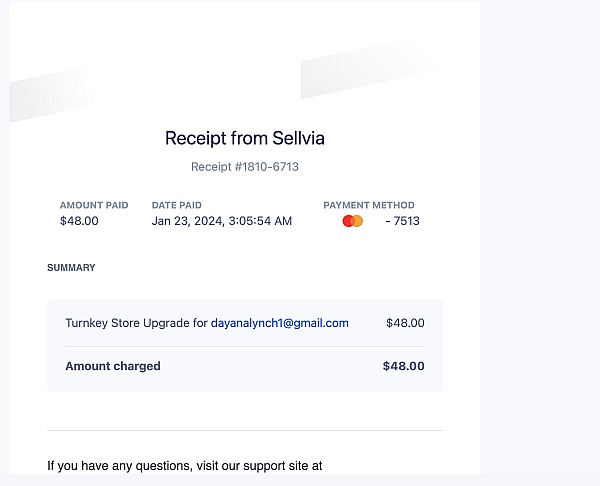Evaluation of customer support and service for dropshipping in the U.S. marketplace on Amazon Seller Shopify, WordPress (WooCommerce) or WordPress is vital as customer satisfaction is dependent on the speed of communication, responsiveness as well as dependable resolution of issues and more. This article provides a brief overview of the support tools and customer service tools offered on each platform.
1. Amazon Seller
Amazon Customer Support Policies
Amazon has strict guidelines on how you communicate with customers. It can be challenging to meet the 24 hour deadline for responding to customer queries.
Handling Refunds and Returns: Amazon's FBA program manages returns and customer queries related to fulfillment, saving time for FBA sellers. Merchant Fulfilled Network will require you to handle all returns, refunds, customer queries and other issues directly.
Help for Sellers
Seller Support: Amazon provides seller assistance through the SellerCentral platform. You can access FAQs, resources and live chat as well as email support, which can help resolve issues like accounts management and order issues.
Amazon makes sellers accountable for parameters such as the Order Defect Rate and the response time. Insufficient customer service can lead to account suspensions. The reliability of customer service is therefore essential.
Amazon Seller Assessment:
Assess Responsiveness: Review Amazon’s customer response time requirements and ensure that you have enough resources or the tools needed to meet them (such automated response systems).
Return Handling: If you're using MFN, ensure that your supplier or fulfillment partner has support for returns. Amazon handles returns if your store uses FBA. However, it's essential to know about any problems that might arise to ensure the satisfaction of customers.
Customer Service Tools: Ensure that you're aware of Seller Central's tools to handle disputes, refunds, and general support inquiries. Think about using third-party software when you want to help meet Amazon’s strict response requirements.
2. Shopify
Apps that incorporate customer service:
Apps for Customer Service: Shopify offers integrations with customer service tools like Gorgias, Zendesk, and Re
You can use a centralized dashboard to manage multiple channels for customers (emails and chats, as also social media).
Automated Communication: Shopify apps allow chatbots, automated responses and FAQs to help customers find answers quickly.
Shopify provides a range of messaging options that can be customized. For instance it is possible to personalize emails for confirmations, abandoned-cart emails, or follow-up messages. These features can help build solid customer relationships and guarantee the highest level of satisfaction.
Order Tracking & Notifications
Shopify offers real-time notifications for customers, with updates on the status of their orders including tracking, shipping, and tracking. This reduces the number of customer queries on order status.
Customer Order Status: Shopify's Order Status page allows customers to view the status of their orders without having to reach customer support.
Evaluation Steps for Storeify
Evaluation of Apps Available: Examine the customer support applications like Gorgias that are integrated directly with Shopify and provide omnichannel support, saving time on managing the customer's inquiries.
Shopify offers a wide range of options to customize email templates, chatbots, and automated replies. This allows you to deliver appropriate and timely communications with your clients.
After-Sale support: Find out if your platform offers customer service options such as return labels, as well as simple refund processing through third-party apps. Shopify can streamline customer satisfaction and return procedures.
3. WordPress (WooCommerce),
Customer Service Plugins
WooCommerce integrates directly with your website's plugins, such as LiveChat as well as Zendesk. These tools offer tickets for customer service and live chat as well as knowledge bases.
Automated Chatbots. For quick responses you can make use of AI-based plug-ins for chatbots, such as Tidio or ChatBot, that automate interactions with customers, assisting customers with their most frequent questions and improving their response time.
Email Notifications WooCommerce offers customized emails for confirmation of orders, shipment, and delivery to give customers visibility on their orders.
Returns tracking and Order Tracking:
Order Tracking plugins: TrackShip, for example offers customers real-time tracking information on your website, which helps reduce the number of inquiries related to orders.
Returns and Refunds WooCommerce lets you customize refund and returns policies using plugins such as WooCommerce RMA that automatize returns. This feature allows you to handle refunds and returns in an efficient way.
Assessment Steps for WooCommerce:
Explore chatbot plugins as well as live chat and ticketing. WooCommerce customers are raving about LiveChat as well as Help Scout, both of that provide integrated customer service.
Automated Communication: Make tracking orders as well as status updates easy available for customers. This reduces the amount of inquiries about the status of orders. TrackShip can provide automatic tracking notifications.
Returns and Refund Policy WooCommerce allows you to set these up in a way that's flexible. Utilize return plugins to enhance the experience of customers. Check out the most popular Sellvia reviews for more info including ecommerce business, best to sell online, ecommerce platform, dropshipping products, best thing to sell online, starting an online company, best ecommerce platform, ecommerce dropshipping, sellvia amazon, e commerce companies and more.

How Do You Determine The Efficacy Of Customer Feedback And Support?
Assessing Customer Feedback and Support for dropshipping platforms such as Amazon Seller, Shopify, and WordPress (WooCommerce) is vital for ensuring a positive customer experience for sellers as well as customers. Each platform has different levels of customer support and feedback mechanisms that could impact business success and satisfaction of customers. This article will help you assess these aspects across three platforms.
1. Amazon Seller
Customer Feedback Mechanisms for Customer Feedback
Amazon's Product Reviews and Ratings feature allows customers to rate items and leave reviews. Feedback is crucial for a seller's image, and could have a profound influence on sales. Ratings that are high increase the credibility and visibility of a seller.
Sellers' Feedback: Buyers who leave feedback directly to sellers can impact their overall rating as well the metrics of performance. Feedback that is negative, particularly if it is consistent, can cause a decrease in visibility, and could even lead to account suspension.
Q&A section: Customers are able to ask questions to sellers as well as other customers. This section helps clarify product details and build trust.
Customer Support Features:
Amazon Customer Support: Amazon offers a comprehensive customer support framework. Sellers aren't directly responsible for support to customers for FBA orders, since Amazon handles returns, inquiries as well as refunds. Sellers are responsible for ensuring customer service for orders that are processed by the merchants.
Return Policy Amazon has a friendly return policy with simple processes for returning items. This improves trust among the customers, but it could be a bit complex for sellers.
Seller Support Amazon offers dedicated support to its sellers. This includes assistance via Seller Central and tools to help resolve issues relating to account health, performance metrics and seller disputes.
Amazon Sellers: How to Evaluate their Performance
Examine Seller Metrics. Check your feedback and rating of the seller to identify areas of improvement. To be credible, you must strive for a an excellent rating.
Review Customer Reviews: Ensure you are reviewing reviews of your products and ask questions from customers often to make sure you're responding quickly and ensuring product quality.
Amazon Resources: Get to know the Amazon Seller Central support features. This includes performance notifications, resolution options and more.
2. Shopify
Customer Feedback Mechanisms
Shopify Store reviews Sellers are able to incorporate review software for customers (e.g. Yotpo or Judge.me) that allow customers to leave reviews directly to the product's pages. This feedback could be crucial to driving sales and increasing trust.
Social Proof: A lot of Shopify stores rely on social proof through testimonials, case studies, or user-generated content posted on social media. This can increase credibility and entice potential customers.
Post-purchase surveys: A few Shopify merchants use post-purchase surveys in order to collect data on customer satisfaction and experience and could be used to make improvements.
Customer Support Features
Shopify's 24/7 Support is accessible via live chat, telephone and email. The support is available to merchants when issues arise. This is crucial for running an effective dropshipping business.
Shopify Help Center is a comprehensive resource that includes tutorials, articles and forums. It provides advice on a wide range of topics including store setup, to online marketing strategies.
Shopify Apps for Customer Service: Shopify offers a range of customer support apps such as Zendesk Gorgias which help customers with enquiries.
Steps of Assessment for Shopify
Integrate feedback: Choose the review app you want to integrate, and decide how to encourage users to leave reviews following purchase.
Test Support Channels. Contact Shopify's support team to evaluate the speed of response as well as the quality of the service offered.
Help Center Resources: Learn how to utilize the Shopify Help Center for efficient solving common problems.
3. WordPress (WooCommerce).
Customer Feedback:
Review of Product: WooCommerce includes built-in review functionality for products, enabling customers to leave reviews and comments. Sellers are able to moderate reviews in order to ensure that they are appropriate and of high quality.
Feedback Plugins. A lot of WooCommerce stores utilize plugins, such as improved review systems or a feedback form that allows the customer to give detailed feedback.
Social Media Integration: WooCommerce encourages customers to post reviews on social media sites. They can be featured on the product's pages for enhanced credibility.
Customer Support Features
WooCommerce customers heavily rely on documentation and the community forums to solve problems. WooCommerce Help Docs offers extensive guidance, however support may be less responsive than Shopify.
Hosting Support WooCommerce sellers typically use managed hosting services that provide customer support. The quality of support offered can differ significantly among hosting providers.
Support systems can be customized: WooCommerce integrates with customer service tools such as Zendesk as well as Freshdesk. This allows sellers the flexibility to handle queries from customers.
WooCommerce Assessment:
Examine Review Functionality Review Features: Ensure that the reviews of products are disabled. Also, assess any additional review plugins to enhance the feedback mechanism.
Check the support for your hosting provider: Contact support to see the level of responsiveness they have and what kind of support is offered.
Develop a Support System: You could consider integrating a helpdesk ticketing system that can handle the customer's inquiries more effectively. Take a look at the top rated Sellvia reviews for blog advice including store dropshipping, ecommerce business for sale, dropshipping business, online selling, online business to buy, e business, ecommerce and dropshipping, make a online shop, online business for sale, successful online businesses and more.
